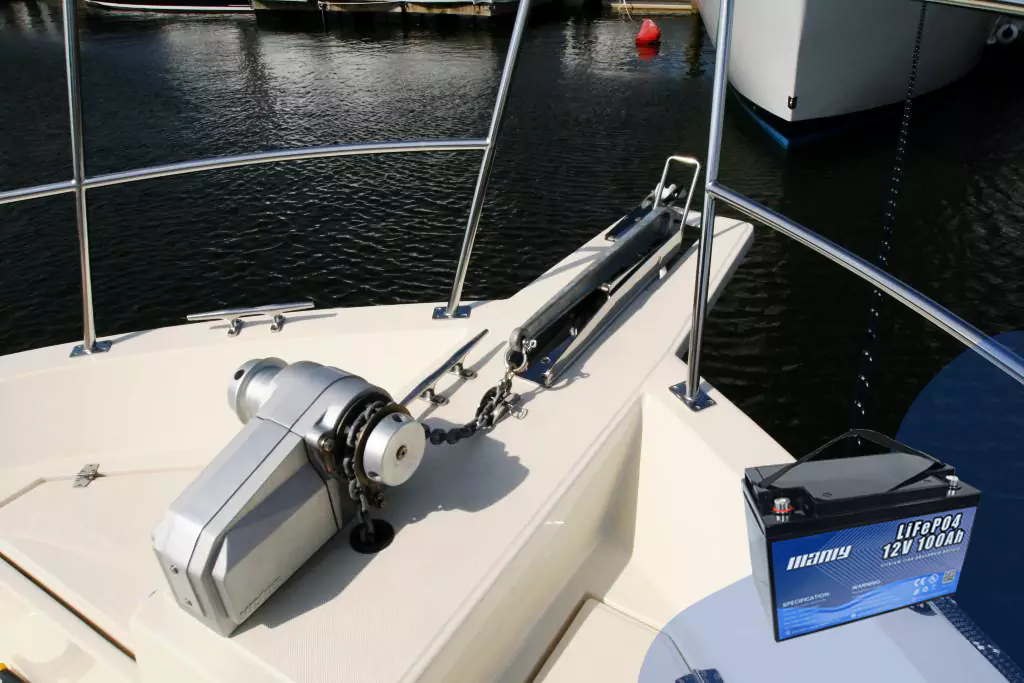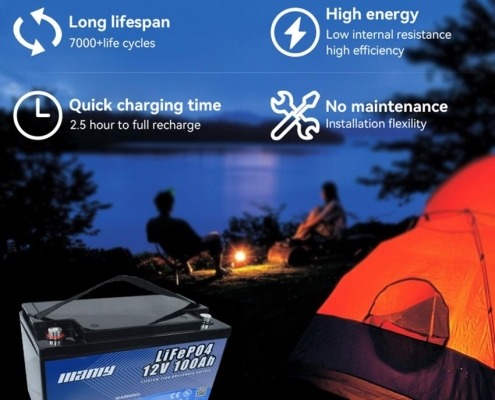2024 Key Insights on Your Boat Windlass and Its Power
Table of Contents
- 2024 Key Insights on Your Boat Windlass and Its Power
- What is a Boat Windlass?
- Different Windlass Types
- How Does a Boat Windlass Operate?
- What Size Windlass Do You Need?
- How Many Amps do Boat Windlasses Draw?
- Where On a Boat are Windlass Breakers Found?
- Do Boat Windlasses Need Their Own Battery?
- Should You Power a Windlass with Lithium Batteries?
- What is the Best Way to Power Your Boat Windlass?
- Learn More About Battery
Everybody deserves a little downtime and leisure time to help them relax now and then, which is what hobbies are for. Some enjoy reading, some take up gardening, and some like to indulge in a spot of fishing. In terms of popularity however, boating is up there amongst the greats.
Boats come in all shapes and sizes, and can be used in a variety of ways. You can use your boat for fishing, you can relax on the lake, sail out to sea, or even live aboard some vessels. Boats really are the ultimate piece of leisure equipment, yet maintaining and powering them is not simple.
The boats widely used nowadays are packed full of features and often require a power source to operate them correctly. Now, with the help of quality batteries such as the MANLY LiFePO4 lithium battery, operating these devices is much simpler than it was decades ago, but that’s no excuse to become complacent.
One of the most essential pieces of equipment on your boat is the windlass, which is what we’re looking at today.
What is a Boat Windlass?
It may have an unusual name, but a windlass on a boat is a hugely important piece of equipment that must be cared for and properly maintained.
When you drop anchor, you want the process to be as simple and straightforward as possible. This is where the windlass proves so effective. A boat’s windlass is basically a large mechanical winch on a boat that is designed specifically to help boats drop and raise anchor as quickly and effortlessly as possible, in the safest possible manner.
The windlass is typically found on a boat’s foredeck and is powered by an electric motor or a crank. If it is powered by an electric motor, it will be known as an electric windlass, whereas if a crank is used, it is a manual windlass.
While there’s a lot of physicals and mechanics involved, put very simply, the boat windlass will securely grasp onto the anchor line in order to pull it up and out of the water.
Different Windlass Types
If you are thinking of getting into boating, understanding not only what a windlass is, but also the different types, is very important.
Typically, there are two different types of boat windlass, these are:
- Vertical capstan
- Horizontal windlass
The vertical and horizontal in the names comes from the position of the shaft. A vertical capstan windlass for example, is better for aesthetics as it will hide more of the mechanical components below deck. The downside is that it will require more space below deck, so if space is something you’re lacking, you wish to opt for a horizonal windlass instead.
A horizontal windlass is perhaps less appealing to the eye as more of the mechanical aspects of the device are visible on deck. If your boat has a smaller anchor locker however, horizontal windlasses are usually the way to go. They require a minimum of 12” (30cm) fall to allow for proper stacking of the anchor rode within the chain locker.
How Does a Boat Windlass Operate?
As mentioned, you can either opt for a manual windlass operated via a crank, or you can go for a more modern, and much easier option, and opt for an electric windlass instead.
There is however, a third option for those fortunate enough to find themselves on a very large vessel, and that is a hydraulic windlass. Found on huge ships and mega-yachts, these are designed to lift incredibly heavy anchors.
A manual crank operated windlass literally requires the user’s own muscle power as they will crank the device themselves. This is a basic and inexpensive option, but it requires a lot of work, and is considered less-safe than an electric windlass.
An electric windlass is perfect for medium-sized boats and provides the best of both worlds. These are the windlasses of choice for many boaters, especially since they can easily be powered by lightweight and portable batteries, just like the LiFePO4 lithium battery from MANLY, which we touched upon previously.
What Size Windlass Do You Need?
Okay, so we know what a boat windlass is, and we know how they work and the different options, but what we don’t yet know is why size windlass is right for you. If you’re operating a tiny one-person rowing boat for example, you wouldn’t want a hydraulic windlass like you’d find on a cargo ship.
While there are many variables to consider, a simple way of getting a rough idea of what size windlass you need, is to factor in the full weight of the ground tackle and anchor, then simply multiply that number by three. So, very simply, if your anchor weighs 20 pounds, and your ground tackle weighs 30 pounds, you would then take the 50 pounds of total weight (20 + 30) and multiply that by 3, giving you a total of 150 pounds (50 x 3 = 150).
By using the above formula, you can then look for a windlass which has a minimum power rating of at least 150 pounds. Simple, huh?
How Many Amps do Boat Windlasses Draw?
Answering this question is a bit like answering how long a piece of string is. In truth, there is no one definitive answer because it depends on a host of other variables.
The amps that boat windlasses draw depends upon their max loads versus the voltage and the working load. Now you can see why answering this is so tricky.
If you’re looking for a very general overview however, most windlasses will draw anything from 35 amps up to 200 amps. As you can see, this could result in some issues regarding charging, as the power from your boat’s engine alone may not be enough to charge up the batteries as you use them.
A great workaround however, and one which many boaters have implemented, is to have an individual house battery system. This system will then use the larger sized battery bank to provide power for the windlass.
Where On a Boat are Windlass Breakers Found?
When it comes to electricity, you can’t take any risks, especially considering the fact that water and electricity do not mix, and boats are, well, you know where boats are found.
Due to the fact that the wires powering an electric windlass will have so many amps of power flowing through them, the correctly rated wires must be used.
Now, due to the size of these wires, often times you’ll find that the wires are not actually located on the master panel at all. Windlass circuit breakers can be found in a number of different spots on a boat. Typically however, you’ll find them either in close proximity to the battery, or situated next to the primary buss which feeds the master electrical panel.
The reason why most boaters will locate their breakers so close to the motor and battery/batteries, is to reduce the distance that the electricity has to travel, and thereby it helps prevent a drop in voltage.
Do Boat Windlasses Need Their Own Battery?
Unless you have a bog-standard, run-of-the-mill rowing boat, chances are your boat will require power for some reason or another. Whether it’s to fire up the engine, power your white goods, or operate the lighting system, boats generally need power.
So, this begs the question of whether windlasses need their own power source, I.E a battery. Well, boat windlasses require a lot of power, especially when dealing with larger, heavier anchors. This is why a lot of boat owners will install separate battery banks. Not only that, but it means you aren’t relying on power from the engine, or solar (if you have a solar setup). You can drop and raise anchor at your leisure. From a safety perspective, this is very important.
Should You Power a Windlass with Lithium Batteries?
Okay, so we’ve established that a windlass works best with its own dedicated power setup, and as we’ve mentioned a few times already, a LiFePO4 lithium battery is the way to go.
In the past, lead-acid batteries were used, and while generally acceptable, they are far inferior to many of the lithium batteries we see on the market nowadays.
Lead acid batteries have shorter lifecycles, they take longer to charge, they discharge quicker, they are much, much heavier, and they are also bad for the environment.
Basically, when it boils down to lead acid vs lithium batteries for powering your boat’s windlass, lithium batteries, such as those offered by MANLY, win every single time.
What is the Best Way to Power Your Boat Windlass?
As you can see, lithium battery power is the way to go when it comes to your boat’s windlass, with many opting for LiFePO4 lithium battery products.
Lithium Iron Phosphate batteries have iron phosphate for the cathode material. They offer superior charging rates, very long life cycles, slow rates of discharge, they’re light in weight, and they’re also incredibly reliable, and better for the environment as well.
If your boat’s windlass is in need of a dedicated power system, a MANLY LiFePO4 battery setup comes very highly recommended indeed.






